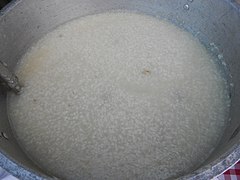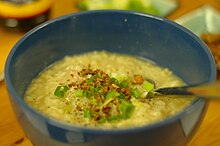Lugaw
 Basic lugaw | |
| Alternative names | pospas, lugao |
|---|---|
| Course | Main dish |
| Place of origin | Philippines |
| Main ingredients | glutinous rice |
| Variations | arroz caldo, goto |
| Similar dishes | Congee |
Lugaw, also spelled lugao, is a Filipino glutinous rice gruel or porridge. Lugaw includes various dishes, both savory and sweet. In Visayan regions, savory lugaw are collectively referred to as pospas. Lugaw is widely regarded as comfort food in the Philippines.[1][2][3]
Description[]
Lugaw is traditionally made by boiling glutinous rice (Tagalog: malagkit; Visayan: pilit). Regular white rice may also be used if boiled with excess water. The basic version is sparsely spiced, usually only using salt, garlic, and ginger; or alternatively, sugar. Heartier versions are cooked in a chicken, fish, pork, or beef broth. It is regarded as a comforting and easy-to-digest food, typically prepared for breakfast and during cold and rainy weather. It is also commonly served to people who are sick or bedridden, and to very young children and the elderly.[4][5]
Lugaw is usually eaten hot or warm, since the gruel congeals if left to cool. It can be reheated by adding a little bit of water.[6][7][8][9] Dessert versions, however, can be eaten cold or even partly frozen.[10]
According to the National Commission for Culture and the Arts, lugaw is among the earliest documented Filipino food. The agency noted that lugaw is among the entries of the 1613 Vocabulario de la Lengua Tagala by Fr. Pedro de San Buenaventura which defines lugaw as a "rice mixed with milk or water or of both (porridge)"[11]
Variants[]
Lugaw can be paired or augmented with numerous other dishes and ingredients.
Savory[]

Most savory versions of lugaw are derived from or influenced by Chinese-style congee, introduced by Chinese-Filipino migrants. It has diverged over the centuries to use Filipino ingredients and suit the local tastes. Filipino savory lugaw are typically thicker than other Asian congees because they use glutinous rice. They are traditionally served with calamansi, soy sauce (toyo), or fish sauce (patis) as condiments[12][13] Savory lugaw are usually paired with meat or seafood dishes. The most common being tokwa't baboy (cubed tofu and pork).[4][5]
- Arroz caldo – lugaw heavily infused with ginger and garnished with toasted garlic, scallions, and black pepper with a hard-boiled egg. Most versions also add safflower (kasubha) which turns the dish characteristically yellow.[2]
- Goto – lugaw made with goto (tripe) and ginger. It is garnished with toasted garlic, scallions, and black pepper.[13][14]
Dessert[]

Sweet versions of lugaw are more characteristically Filipino. They include:
- Binignit – lugaw made with coconut milk (gata) and various slices of fruit, jelly desserts (like sago, tapioca pearls, kaong, etc.), and root crops (like sweet potato, taro, and ube). It is known by many other regional names, like giná-tan, tabirák, alpahor, ginettaán, ginat-ang lugaw, and kamlo.[10]
- Champorado – lugaw with home-made chocolate and milk. It is a native adaptation of the Mexican drink champurrado. It is traditionally paired with dried fish (tuyo), but can be eaten as is as a dessert.[15]
- Ginataang mais – lugaw made with coconut milk and sweet corn.[16]
- Ginataang munggo – lugaw with toasted mung beans, sugar, and coconut milk. Corn may also be added.[17]
See also[]
- Ginataan
- Kiampong
- Sinangag
- Congee
References[]
- ^ Castro, Jasper. "Here's How To Tell Lugaw, Congee, Goto, and Arroz Caldo From Each Other". Yummy.ph. Retrieved 6 December 2018.
- ^ Jump up to: a b Reynaldo G. Alejandro (1985). The Philippine Cookbook. Penguin. p. 38. ISBN 9780399511448.
- ^ Miranda, Pauline. "The difference between lugaw, goto, and arroz caldo". Nolisolo. Retrieved 6 December 2018.
- ^ Jump up to: a b Ignacio, Michelle. "Lugaw with Tokwa't Baboy: A Pinoy Favorite". Certified Foodies. Retrieved 7 December 2018.
- ^ Jump up to: a b Veneracion, Connie. "Lugaw (congee) with tokwa't baboy (tofu and pork)". Casa Veneracion. Retrieved 7 December 2018.
- ^ Agbanlog, Liza. "Arroz Caldo (Filipino Style Congee)". Salu Salo Recipes. Retrieved 6 December 2018.
- ^ "Arroz Caldo". Genius Kitchen. Retrieved 6 December 2018.
- ^ "Chicken Arroz Caldo – A Filipino Christmas Rice Porridge". Wishful Chef. Retrieved 6 December 2018.
- ^ Phanomrat, Jen. "Filipino Arroz Caldo". Tastemade. Retrieved 6 December 2018.
- ^ Jump up to: a b "Holiday Benignit / Ginataan". Market Manila. Retrieved 7 December 2018.
- ^ Noriega, Richa (2 April 2021). "'Lugaw' is a PH cultural symbol – NCCA". Manila Bulletin. Retrieved 3 April 2021.
- ^ Trivedi-Grenier, Leena (2 February 2018). "Janice Dulce passes along Filipino culture via arroz caldo". San Francisco Chronicle. Retrieved 6 December 2018.
- ^ Jump up to: a b Edgie Polistico (2017). Philippine Food, Cooking, & Dining Dictionary. Anvil Publishing, Incorporated. ISBN 9786214200870.
- ^ "Goto". Kawaling Pinoy. Retrieved 6 December 2018.
- ^ Chikiamco, Norma (16 May 2013). "Quick and easy 'champorado'". Philippine Daily Inquirer. Retrieved 7 December 2018.
- ^ "Ginataang Mais". Kawaling Pinoy. Retrieved 7 December 2018.
- ^ Alvarez, Lhas. "Ginataang Monggo Recipe". Yummy.ph. Retrieved 19 April 2019.
- Rice dishes
- Philippine desserts
- Philippine rice dishes
